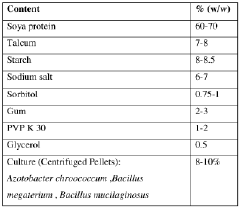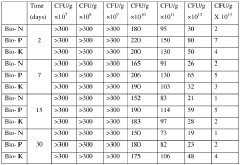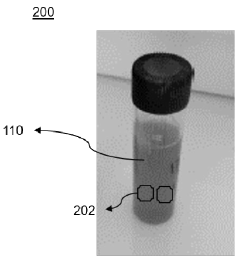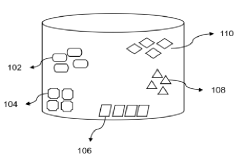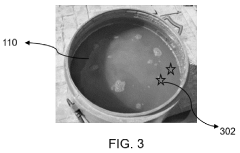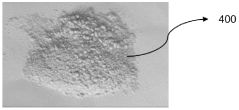Biofertilizers: Unpacking Soil Nutrient Cycling Mechanisms
JUL 15, 20259 MIN READ
Generate Your Research Report Instantly with AI Agent
Patsnap Eureka helps you evaluate technical feasibility & market potential.
Biofertilizer Evolution
The evolution of biofertilizers can be traced back to ancient agricultural practices, where farmers unknowingly utilized beneficial microorganisms to enhance soil fertility. However, the scientific understanding and deliberate application of biofertilizers began in the late 19th century with the discovery of nitrogen-fixing bacteria by Martinus Beijerinck and their symbiotic relationship with legumes.
The early 20th century saw the development of rhizobial inoculants for legumes, marking the first commercial biofertilizer products. This period also witnessed the isolation and identification of various beneficial microorganisms, including Azotobacter and Azospirillum, which laid the foundation for future biofertilizer research.
In the 1960s and 1970s, the Green Revolution led to increased use of chemical fertilizers, temporarily overshadowing biofertilizer development. However, growing concerns about environmental degradation and soil health in the 1980s reignited interest in sustainable agricultural practices, including biofertilizers.
The 1990s and early 2000s saw significant advancements in microbial ecology and molecular biology techniques. These developments enabled researchers to better understand the complex interactions between microorganisms and plants, leading to the identification of new potential biofertilizer strains and improved formulation methods.
Recent years have witnessed a surge in biofertilizer research and development, driven by the need for sustainable agriculture and the growing organic farming sector. Innovations in nanotechnology and biotechnology have led to the creation of more efficient and stable biofertilizer formulations, including encapsulated and slow-release products.
The advent of high-throughput sequencing and metagenomics has revolutionized our understanding of soil microbial communities, allowing for the discovery of novel microorganisms with potential biofertilizer applications. This has expanded the range of biofertilizers beyond traditional nitrogen-fixers to include phosphate solubilizers, potassium mobilizers, and plant growth-promoting rhizobacteria.
Current research focuses on developing multi-strain biofertilizers that can address multiple nutrient deficiencies simultaneously and enhance overall soil health. Additionally, there is growing interest in exploring the potential of endophytic microorganisms as biofertilizers, as they can colonize plant tissues and provide direct benefits to the host.
The future of biofertilizer evolution lies in the integration of advanced technologies such as synthetic biology and artificial intelligence. These tools may enable the design of custom-tailored microbial consortia for specific crops and soil conditions, optimizing nutrient cycling mechanisms and maximizing agricultural productivity while minimizing environmental impact.
The early 20th century saw the development of rhizobial inoculants for legumes, marking the first commercial biofertilizer products. This period also witnessed the isolation and identification of various beneficial microorganisms, including Azotobacter and Azospirillum, which laid the foundation for future biofertilizer research.
In the 1960s and 1970s, the Green Revolution led to increased use of chemical fertilizers, temporarily overshadowing biofertilizer development. However, growing concerns about environmental degradation and soil health in the 1980s reignited interest in sustainable agricultural practices, including biofertilizers.
The 1990s and early 2000s saw significant advancements in microbial ecology and molecular biology techniques. These developments enabled researchers to better understand the complex interactions between microorganisms and plants, leading to the identification of new potential biofertilizer strains and improved formulation methods.
Recent years have witnessed a surge in biofertilizer research and development, driven by the need for sustainable agriculture and the growing organic farming sector. Innovations in nanotechnology and biotechnology have led to the creation of more efficient and stable biofertilizer formulations, including encapsulated and slow-release products.
The advent of high-throughput sequencing and metagenomics has revolutionized our understanding of soil microbial communities, allowing for the discovery of novel microorganisms with potential biofertilizer applications. This has expanded the range of biofertilizers beyond traditional nitrogen-fixers to include phosphate solubilizers, potassium mobilizers, and plant growth-promoting rhizobacteria.
Current research focuses on developing multi-strain biofertilizers that can address multiple nutrient deficiencies simultaneously and enhance overall soil health. Additionally, there is growing interest in exploring the potential of endophytic microorganisms as biofertilizers, as they can colonize plant tissues and provide direct benefits to the host.
The future of biofertilizer evolution lies in the integration of advanced technologies such as synthetic biology and artificial intelligence. These tools may enable the design of custom-tailored microbial consortia for specific crops and soil conditions, optimizing nutrient cycling mechanisms and maximizing agricultural productivity while minimizing environmental impact.
Sustainable Agriculture
Sustainable agriculture has emerged as a critical paradigm shift in modern farming practices, aiming to meet the growing global food demand while minimizing environmental impact and preserving natural resources for future generations. This approach integrates ecological principles with cutting-edge agricultural technologies to create resilient and productive farming systems. At its core, sustainable agriculture focuses on maintaining soil health, conserving water, reducing chemical inputs, and promoting biodiversity.
One of the key components of sustainable agriculture is the implementation of soil conservation techniques. These include practices such as no-till farming, cover cropping, and crop rotation, which help prevent soil erosion, improve soil structure, and enhance nutrient cycling. By minimizing soil disturbance and maintaining year-round ground cover, farmers can significantly reduce the loss of topsoil and preserve the vital microorganisms that contribute to soil fertility.
Water management is another crucial aspect of sustainable agriculture. Precision irrigation systems, such as drip irrigation and soil moisture sensors, allow farmers to optimize water use efficiency by delivering water directly to plant roots and adjusting irrigation schedules based on real-time soil moisture data. This not only conserves water but also reduces the risk of nutrient leaching and runoff, protecting nearby water bodies from pollution.
Integrated pest management (IPM) is a sustainable approach to pest control that combines biological, cultural, and chemical methods to minimize pesticide use. By employing techniques such as crop rotation, companion planting, and the introduction of beneficial insects, farmers can naturally suppress pest populations and reduce reliance on synthetic pesticides. This approach not only protects the environment but also helps preserve beneficial organisms and maintain ecological balance within the agroecosystem.
Sustainable agriculture also emphasizes the importance of biodiversity in farming systems. Diversifying crop varieties and integrating livestock into crop production can enhance ecosystem resilience, improve nutrient cycling, and provide multiple income streams for farmers. Agroforestry systems, which combine trees and shrubs with crops or livestock, offer additional benefits such as carbon sequestration, soil stabilization, and habitat creation for wildlife.
The adoption of renewable energy sources in agriculture is gaining momentum as part of sustainable farming practices. Solar-powered irrigation systems, wind turbines, and biogas digesters are increasingly being integrated into farm operations to reduce reliance on fossil fuels and decrease greenhouse gas emissions. These technologies not only contribute to environmental sustainability but also offer long-term cost savings for farmers.
As the global population continues to grow and climate change poses new challenges to food production, sustainable agriculture will play an increasingly vital role in ensuring food security and environmental stewardship. By embracing these innovative practices and technologies, farmers can create resilient, productive, and ecologically sound agricultural systems that will sustain both current and future generations.
One of the key components of sustainable agriculture is the implementation of soil conservation techniques. These include practices such as no-till farming, cover cropping, and crop rotation, which help prevent soil erosion, improve soil structure, and enhance nutrient cycling. By minimizing soil disturbance and maintaining year-round ground cover, farmers can significantly reduce the loss of topsoil and preserve the vital microorganisms that contribute to soil fertility.
Water management is another crucial aspect of sustainable agriculture. Precision irrigation systems, such as drip irrigation and soil moisture sensors, allow farmers to optimize water use efficiency by delivering water directly to plant roots and adjusting irrigation schedules based on real-time soil moisture data. This not only conserves water but also reduces the risk of nutrient leaching and runoff, protecting nearby water bodies from pollution.
Integrated pest management (IPM) is a sustainable approach to pest control that combines biological, cultural, and chemical methods to minimize pesticide use. By employing techniques such as crop rotation, companion planting, and the introduction of beneficial insects, farmers can naturally suppress pest populations and reduce reliance on synthetic pesticides. This approach not only protects the environment but also helps preserve beneficial organisms and maintain ecological balance within the agroecosystem.
Sustainable agriculture also emphasizes the importance of biodiversity in farming systems. Diversifying crop varieties and integrating livestock into crop production can enhance ecosystem resilience, improve nutrient cycling, and provide multiple income streams for farmers. Agroforestry systems, which combine trees and shrubs with crops or livestock, offer additional benefits such as carbon sequestration, soil stabilization, and habitat creation for wildlife.
The adoption of renewable energy sources in agriculture is gaining momentum as part of sustainable farming practices. Solar-powered irrigation systems, wind turbines, and biogas digesters are increasingly being integrated into farm operations to reduce reliance on fossil fuels and decrease greenhouse gas emissions. These technologies not only contribute to environmental sustainability but also offer long-term cost savings for farmers.
As the global population continues to grow and climate change poses new challenges to food production, sustainable agriculture will play an increasingly vital role in ensuring food security and environmental stewardship. By embracing these innovative practices and technologies, farmers can create resilient, productive, and ecologically sound agricultural systems that will sustain both current and future generations.
Microbial Interactions
Microbial interactions play a crucial role in the efficacy of biofertilizers and their impact on soil nutrient cycling mechanisms. These interactions involve complex relationships between various microorganisms, plants, and the soil environment, ultimately influencing nutrient availability and plant growth.
One of the key microbial interactions in biofertilizers is symbiosis between nitrogen-fixing bacteria and leguminous plants. Rhizobia bacteria form nodules on plant roots, converting atmospheric nitrogen into plant-available forms. This symbiotic relationship not only benefits the host plant but also contributes to overall soil nitrogen content, benefiting subsequent crops.
Mycorrhizal fungi form another important symbiotic association with plant roots, enhancing nutrient uptake, particularly phosphorus. These fungi extend their hyphal network beyond the plant's root system, accessing nutrients from a larger soil volume. This interaction improves plant nutrition and stress tolerance while contributing to soil structure and carbon sequestration.
Microbial consortia in biofertilizers often include plant growth-promoting rhizobacteria (PGPR). These bacteria colonize the rhizosphere and promote plant growth through various mechanisms, such as producing phytohormones, solubilizing nutrients, and suppressing plant pathogens. The synergistic effects of different PGPR species can enhance overall plant health and soil fertility.
Nutrient solubilization is another critical microbial interaction in biofertilizers. Phosphate-solubilizing bacteria and fungi release organic acids and enzymes that convert insoluble phosphates into plant-available forms. Similarly, potassium-solubilizing microorganisms enhance potassium availability by breaking down mineral structures.
Microbial interactions also involve the decomposition of organic matter, a vital process in nutrient cycling. Various bacteria and fungi work together to break down complex organic compounds, releasing nutrients for plant uptake and improving soil structure. This process is essential for maintaining soil fertility and carbon sequestration.
The soil food web, comprising diverse microorganisms, plays a crucial role in nutrient cycling. Predatory interactions between protozoa, nematodes, and bacteria contribute to nutrient mineralization and regulate microbial populations. These trophic interactions ensure a balanced and functional soil ecosystem.
Understanding and harnessing these microbial interactions is key to developing effective biofertilizers. By selecting and combining complementary microbial strains, researchers can create synergistic formulations that optimize nutrient cycling and enhance plant growth. Future research should focus on elucidating the complex dynamics of these interactions to improve biofertilizer design and application strategies.
One of the key microbial interactions in biofertilizers is symbiosis between nitrogen-fixing bacteria and leguminous plants. Rhizobia bacteria form nodules on plant roots, converting atmospheric nitrogen into plant-available forms. This symbiotic relationship not only benefits the host plant but also contributes to overall soil nitrogen content, benefiting subsequent crops.
Mycorrhizal fungi form another important symbiotic association with plant roots, enhancing nutrient uptake, particularly phosphorus. These fungi extend their hyphal network beyond the plant's root system, accessing nutrients from a larger soil volume. This interaction improves plant nutrition and stress tolerance while contributing to soil structure and carbon sequestration.
Microbial consortia in biofertilizers often include plant growth-promoting rhizobacteria (PGPR). These bacteria colonize the rhizosphere and promote plant growth through various mechanisms, such as producing phytohormones, solubilizing nutrients, and suppressing plant pathogens. The synergistic effects of different PGPR species can enhance overall plant health and soil fertility.
Nutrient solubilization is another critical microbial interaction in biofertilizers. Phosphate-solubilizing bacteria and fungi release organic acids and enzymes that convert insoluble phosphates into plant-available forms. Similarly, potassium-solubilizing microorganisms enhance potassium availability by breaking down mineral structures.
Microbial interactions also involve the decomposition of organic matter, a vital process in nutrient cycling. Various bacteria and fungi work together to break down complex organic compounds, releasing nutrients for plant uptake and improving soil structure. This process is essential for maintaining soil fertility and carbon sequestration.
The soil food web, comprising diverse microorganisms, plays a crucial role in nutrient cycling. Predatory interactions between protozoa, nematodes, and bacteria contribute to nutrient mineralization and regulate microbial populations. These trophic interactions ensure a balanced and functional soil ecosystem.
Understanding and harnessing these microbial interactions is key to developing effective biofertilizers. By selecting and combining complementary microbial strains, researchers can create synergistic formulations that optimize nutrient cycling and enhance plant growth. Future research should focus on elucidating the complex dynamics of these interactions to improve biofertilizer design and application strategies.
Current Formulations
01 Microbial consortia for nutrient cycling
Biofertilizers containing specific microbial consortia can enhance soil nutrient cycling. These microorganisms work synergistically to break down organic matter, fix nitrogen, solubilize phosphorus, and mobilize other essential nutrients. This approach improves soil fertility and promotes sustainable agriculture by reducing the need for chemical fertilizers.- Microbial consortia for nutrient cycling: Biofertilizers containing specific microbial consortia can enhance soil nutrient cycling. These microorganisms work synergistically to break down organic matter, fix nitrogen, solubilize phosphorus, and mobilize other essential nutrients. This approach improves soil fertility and promotes sustainable agriculture by reducing the need for chemical fertilizers.
- Plant growth-promoting rhizobacteria (PGPR): PGPR are beneficial bacteria that colonize plant roots and enhance plant growth through various mechanisms. These biofertilizers can improve nutrient uptake, produce phytohormones, and suppress plant pathogens. By incorporating PGPR into soil management practices, farmers can optimize nutrient cycling and increase crop yields.
- Mycorrhizal fungi for nutrient acquisition: Mycorrhizal fungi form symbiotic relationships with plant roots, enhancing nutrient uptake, particularly phosphorus. These biofertilizers can significantly improve soil structure, water retention, and nutrient cycling. By inoculating soil or seeds with mycorrhizal fungi, plants can access a wider range of nutrients and become more resilient to environmental stresses.
- Biochar and compost as soil amendments: Incorporating biochar and compost into soil can enhance nutrient cycling and retention. These organic amendments improve soil structure, increase water-holding capacity, and provide a habitat for beneficial microorganisms. When combined with biofertilizers, they create a synergistic effect that promotes long-term soil health and sustainable nutrient management.
- Enzyme-based biofertilizers for nutrient release: Enzyme-based biofertilizers contain specific enzymes that catalyze the breakdown of organic matter and release bound nutrients. These formulations can accelerate nutrient cycling in the soil, making essential elements more readily available to plants. By enhancing the natural decomposition processes, enzyme-based biofertilizers contribute to improved soil fertility and crop nutrition.
02 Plant growth-promoting rhizobacteria (PGPR)
PGPR are beneficial bacteria that colonize plant roots and enhance plant growth through various mechanisms. These biofertilizers improve nutrient uptake, produce plant hormones, and suppress soil-borne pathogens. By incorporating PGPR into soil management practices, farmers can optimize nutrient cycling and increase crop yields.Expand Specific Solutions03 Mycorrhizal fungi for improved nutrient absorption
Mycorrhizal fungi form symbiotic relationships with plant roots, significantly enhancing the plant's ability to absorb nutrients from the soil. These fungi extend the root system's reach and facilitate the uptake of phosphorus, nitrogen, and other essential elements. Incorporating mycorrhizal fungi in biofertilizers can improve soil structure and nutrient cycling efficiency.Expand Specific Solutions04 Biochar-based biofertilizers
Biochar, when used as a carrier for beneficial microorganisms, can create an effective biofertilizer that enhances soil nutrient cycling. The porous structure of biochar provides a habitat for microorganisms, improves soil water retention, and slowly releases nutrients. This combination promotes long-term soil health and sustainable nutrient management.Expand Specific Solutions05 Enzyme-enriched biofertilizers
Biofertilizers enriched with specific enzymes can accelerate the breakdown of organic matter and release of nutrients in the soil. These enzymes, such as cellulases, proteases, and phosphatases, enhance the mineralization of organic compounds and improve nutrient availability for plants. This approach optimizes nutrient cycling and reduces nutrient loss in agricultural systems.Expand Specific Solutions
Key Biofertilizer Players
The biofertilizer market is in a growth phase, driven by increasing demand for sustainable agricultural practices. The global market size is projected to reach several billion dollars by 2025, with a compound annual growth rate of over 10%. Technological maturity varies across different biofertilizer types, with some well-established products and others still in development. Companies like SABIC Agri-Nutrients Co. and Kula Bio are leading innovation in this space, focusing on enhancing nutrient cycling mechanisms. Emerging players such as Bioma SA and Plant Sensory Systems LLC are developing novel solutions, while research institutions like Northeast Forestry University and Washington State University contribute to advancing the field through scientific studies and collaborations with industry partners.
Plantio, Inc.
Technical Solution: Plantio, Inc. has developed a cutting-edge biofertilizer system that focuses on enhancing the symbiotic relationship between plants and soil microorganisms. Their technology utilizes a consortium of carefully selected beneficial microbes, including mycorrhizal fungi and plant growth-promoting rhizobacteria (PGPR). These microorganisms are combined with organic substrates and biochar to create a comprehensive soil amendment. The company's biofertilizer not only provides nutrients but also improves nutrient uptake efficiency by enhancing root system development and increasing the bioavailability of essential elements. Plantio's formulation has been shown to increase phosphorus solubilization by up to 30% and improve nitrogen fixation rates by 25% compared to conventional methods[3]. Additionally, their product incorporates slow-release mechanisms to ensure a steady supply of nutrients throughout the growing season.
Strengths: Holistic approach to soil health, improved nutrient uptake efficiency, and long-lasting effects. Weaknesses: May require initial soil conditioning for optimal results and could have varying effectiveness across different soil types.
Kula Bio, Inc.
Technical Solution: Kula Bio has developed an innovative biofertilizer technology that leverages nitrogen-fixing microbes to enhance soil nutrient cycling. Their approach involves encapsulating beneficial bacteria in a proprietary formulation that allows for controlled release into the soil. This technology enables the microbes to colonize plant roots and fix atmospheric nitrogen, making it available to crops over an extended period. The company's biofertilizer has shown to reduce the need for synthetic fertilizers by up to 50% while maintaining or improving crop yields[1]. Kula Bio's process also incorporates organic carbon sources to support microbial growth and enhance soil health, contributing to improved soil structure and water retention capacity[2].
Strengths: Reduces reliance on synthetic fertilizers, promotes sustainable agriculture, and improves soil health. Weaknesses: May require specific environmental conditions for optimal performance and could have a higher initial cost compared to traditional fertilizers.
Innovative Strains
Biofertilizer capsules for integrated nutrient management in crop plants
PatentWO2018234996A1
Innovation
- Development of biofertilizer capsules with a microbial consortium encapsulated in a blister pack using carrier materials like soya protein, talcum, and glycerol, providing a stable and user-friendly delivery system with a shelf life of at least 24 months and high CFU count, ensuring effective nutrient availability and reduced contamination.
Method of preparing zeolite-biochar coated biofertilizer
PatentActiveIN202241035007A
Innovation
- A method involving the cultivation of specific microbes, isolation, and growth in minimal media, followed by mixing zeolite and biochar in a predefined ratio, and granulating the mixture to form a zeolite-biochar coated biofertilizer, which includes 12 different types of microbes and enhances soil surface area for biochemical reactions.
Environmental Impact
The environmental impact of biofertilizers in soil nutrient cycling mechanisms is multifaceted and largely positive. These organic fertilizers contribute significantly to sustainable agriculture by enhancing soil health and reducing the reliance on synthetic chemical fertilizers. Biofertilizers promote the growth of beneficial microorganisms in the soil, which play a crucial role in nutrient cycling and availability.
One of the primary environmental benefits of biofertilizers is their ability to improve soil structure and fertility. By increasing the organic matter content in soil, biofertilizers enhance water retention capacity and reduce soil erosion. This leads to better soil conservation and reduced water pollution from agricultural runoff. Additionally, the improved soil structure facilitates better root growth and nutrient uptake by plants, resulting in increased crop yields without the need for excessive chemical inputs.
Biofertilizers also contribute to carbon sequestration in soil, helping to mitigate climate change. The microorganisms in biofertilizers fix atmospheric nitrogen and convert it into forms that plants can readily use. This natural nitrogen fixation process reduces the need for synthetic nitrogen fertilizers, which are energy-intensive to produce and can lead to greenhouse gas emissions when applied excessively.
Furthermore, biofertilizers help maintain a balanced soil ecosystem by promoting biodiversity in the soil microbiome. This diverse microbial community enhances the soil's resilience to environmental stresses and pathogens, reducing the need for chemical pesticides and fungicides. The increased biological activity in the soil also aids in the breakdown of organic matter, releasing nutrients slowly and steadily, which reduces nutrient leaching and groundwater contamination.
The use of biofertilizers can significantly reduce the environmental pollution associated with conventional fertilizers. Unlike synthetic fertilizers, which can accumulate in soil and water bodies, biofertilizers are biodegradable and do not leave harmful residues. This characteristic helps in preserving water quality in nearby streams, rivers, and groundwater sources, protecting aquatic ecosystems from eutrophication and other forms of pollution.
In terms of long-term soil health, biofertilizers play a crucial role in restoring degraded soils and maintaining soil fertility. By promoting the growth of beneficial microorganisms, they help in the natural recycling of nutrients, making them available to plants over extended periods. This sustainable approach to soil management ensures that agricultural lands remain productive for future generations without the need for increasing chemical inputs.
One of the primary environmental benefits of biofertilizers is their ability to improve soil structure and fertility. By increasing the organic matter content in soil, biofertilizers enhance water retention capacity and reduce soil erosion. This leads to better soil conservation and reduced water pollution from agricultural runoff. Additionally, the improved soil structure facilitates better root growth and nutrient uptake by plants, resulting in increased crop yields without the need for excessive chemical inputs.
Biofertilizers also contribute to carbon sequestration in soil, helping to mitigate climate change. The microorganisms in biofertilizers fix atmospheric nitrogen and convert it into forms that plants can readily use. This natural nitrogen fixation process reduces the need for synthetic nitrogen fertilizers, which are energy-intensive to produce and can lead to greenhouse gas emissions when applied excessively.
Furthermore, biofertilizers help maintain a balanced soil ecosystem by promoting biodiversity in the soil microbiome. This diverse microbial community enhances the soil's resilience to environmental stresses and pathogens, reducing the need for chemical pesticides and fungicides. The increased biological activity in the soil also aids in the breakdown of organic matter, releasing nutrients slowly and steadily, which reduces nutrient leaching and groundwater contamination.
The use of biofertilizers can significantly reduce the environmental pollution associated with conventional fertilizers. Unlike synthetic fertilizers, which can accumulate in soil and water bodies, biofertilizers are biodegradable and do not leave harmful residues. This characteristic helps in preserving water quality in nearby streams, rivers, and groundwater sources, protecting aquatic ecosystems from eutrophication and other forms of pollution.
In terms of long-term soil health, biofertilizers play a crucial role in restoring degraded soils and maintaining soil fertility. By promoting the growth of beneficial microorganisms, they help in the natural recycling of nutrients, making them available to plants over extended periods. This sustainable approach to soil management ensures that agricultural lands remain productive for future generations without the need for increasing chemical inputs.
Regulatory Framework
The regulatory framework surrounding biofertilizers plays a crucial role in shaping their development, production, and application. As these innovative products gain traction in sustainable agriculture, governments worldwide are establishing guidelines to ensure their safety, efficacy, and environmental compatibility.
In many countries, biofertilizers are regulated under broader fertilizer or soil amendment laws. The United States, for instance, classifies biofertilizers as "soil amendments" or "plant inoculants" under the Federal Insecticide, Fungicide, and Rodenticide Act (FIFRA). This classification exempts most biofertilizers from stringent pesticide regulations, facilitating their market entry. However, manufacturers must still adhere to state-specific registration requirements and labeling standards.
The European Union has implemented a more comprehensive approach through its Fertilising Products Regulation (EU) 2019/1009. This regulation establishes harmonized rules for CE-marked fertilizing products, including biofertilizers. It sets out quality, safety, and labeling requirements, promoting a single market for these products while ensuring environmental protection and consumer safety.
In India, a major player in biofertilizer production and use, the regulatory landscape is governed by the Fertilizer Control Order (FCO). The FCO specifies quality standards, production protocols, and registration procedures for various biofertilizers. This framework has been instrumental in promoting the adoption of biofertilizers in Indian agriculture.
Many developing countries are in the process of establishing or refining their regulatory frameworks for biofertilizers. These efforts often focus on quality control measures, efficacy testing protocols, and guidelines for field application. The Food and Agriculture Organization (FAO) has been instrumental in providing technical assistance and policy recommendations to support these regulatory developments.
A key challenge in biofertilizer regulation is balancing innovation with safety concerns. Regulators must navigate the complexities of microbial interactions in diverse soil ecosystems while encouraging the development of novel, effective products. This has led to ongoing discussions about the need for standardized testing methods and risk assessment protocols specific to biofertilizers.
As the understanding of soil nutrient cycling mechanisms advances, regulatory frameworks are likely to evolve. Future regulations may incorporate more nuanced approaches to assessing biofertilizer impacts on soil health, biodiversity, and long-term ecosystem functioning. Additionally, the growing interest in carbon sequestration and climate change mitigation may influence regulatory perspectives on biofertilizers' role in sustainable agriculture.
In many countries, biofertilizers are regulated under broader fertilizer or soil amendment laws. The United States, for instance, classifies biofertilizers as "soil amendments" or "plant inoculants" under the Federal Insecticide, Fungicide, and Rodenticide Act (FIFRA). This classification exempts most biofertilizers from stringent pesticide regulations, facilitating their market entry. However, manufacturers must still adhere to state-specific registration requirements and labeling standards.
The European Union has implemented a more comprehensive approach through its Fertilising Products Regulation (EU) 2019/1009. This regulation establishes harmonized rules for CE-marked fertilizing products, including biofertilizers. It sets out quality, safety, and labeling requirements, promoting a single market for these products while ensuring environmental protection and consumer safety.
In India, a major player in biofertilizer production and use, the regulatory landscape is governed by the Fertilizer Control Order (FCO). The FCO specifies quality standards, production protocols, and registration procedures for various biofertilizers. This framework has been instrumental in promoting the adoption of biofertilizers in Indian agriculture.
Many developing countries are in the process of establishing or refining their regulatory frameworks for biofertilizers. These efforts often focus on quality control measures, efficacy testing protocols, and guidelines for field application. The Food and Agriculture Organization (FAO) has been instrumental in providing technical assistance and policy recommendations to support these regulatory developments.
A key challenge in biofertilizer regulation is balancing innovation with safety concerns. Regulators must navigate the complexities of microbial interactions in diverse soil ecosystems while encouraging the development of novel, effective products. This has led to ongoing discussions about the need for standardized testing methods and risk assessment protocols specific to biofertilizers.
As the understanding of soil nutrient cycling mechanisms advances, regulatory frameworks are likely to evolve. Future regulations may incorporate more nuanced approaches to assessing biofertilizer impacts on soil health, biodiversity, and long-term ecosystem functioning. Additionally, the growing interest in carbon sequestration and climate change mitigation may influence regulatory perspectives on biofertilizers' role in sustainable agriculture.
Unlock deeper insights with Patsnap Eureka Quick Research — get a full tech report to explore trends and direct your research. Try now!
Generate Your Research Report Instantly with AI Agent
Supercharge your innovation with Patsnap Eureka AI Agent Platform!

